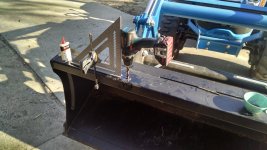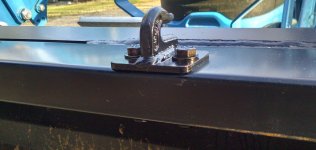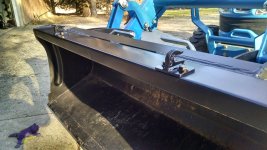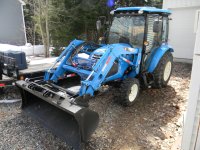elbowroom
Bronze Member
Discussed before, but I'd thought I'd add my thoughts and pictures on the installation:
The LS bucket has a rectangular tube on the top edge that is wrapped by the sheet steel bucket material. It goes over the top, down the front and terminates just in from the edge of the tube. It is welded to the tube underneath. This provides a strong connection with the bolt on hooks. The difficulty is drilling the holes straight and not interfering with the existing welds. This picture shows how I kept alignment when going through the tube:

I drilled a pilot hole in the top and used a 1/2" drill to open it up and continue through the bottom. I had no issues maintaining alignment (the bolts dropped right through) and also no issue with the seam weld on the tubing.
The base plate for the hooks was located flush with the front edge. This put the bottom hole very close to the existing weld underneath. In order to get the washer to lay flat, I did have to grind the weld back a bit. Moving the hook plate back from the front edge 1/4" would have been ideal. However, next to the weld should provide good strength. Guessing, but I probably got 75 lb-ft of torque on the nuts and they did draw tight with no feeling of the tube collapsing.


I debating getting weld on hooks as I have a decent MIG, but was not confident in my skills if I have to support heavy loads safely. Would be easy to lay a bead across the back plate, but there is no way these are going to pull through the tube!
Easy install, nice to have this feature now.
The LS bucket has a rectangular tube on the top edge that is wrapped by the sheet steel bucket material. It goes over the top, down the front and terminates just in from the edge of the tube. It is welded to the tube underneath. This provides a strong connection with the bolt on hooks. The difficulty is drilling the holes straight and not interfering with the existing welds. This picture shows how I kept alignment when going through the tube:

I drilled a pilot hole in the top and used a 1/2" drill to open it up and continue through the bottom. I had no issues maintaining alignment (the bolts dropped right through) and also no issue with the seam weld on the tubing.
The base plate for the hooks was located flush with the front edge. This put the bottom hole very close to the existing weld underneath. In order to get the washer to lay flat, I did have to grind the weld back a bit. Moving the hook plate back from the front edge 1/4" would have been ideal. However, next to the weld should provide good strength. Guessing, but I probably got 75 lb-ft of torque on the nuts and they did draw tight with no feeling of the tube collapsing.


I debating getting weld on hooks as I have a decent MIG, but was not confident in my skills if I have to support heavy loads safely. Would be easy to lay a bead across the back plate, but there is no way these are going to pull through the tube!
Easy install, nice to have this feature now.

